A balsamic pasta salad flavors al dente noodles with juicy cherry tomatoes, crisp cucumber, tangy feta or mozzarella, and a glossy olive oil–balsamic dressing. Start by cooking pasta in salted water, then rinse and cool. Chop vegetables, crumble cheese, and whisk a precise vinaigrette with olive oil, balsamic, and herbs. Toss everything gently in a wide bowl to keep textures intact. Serve chilled or at room temperature, with leftovers kept airtight for later enjoyment as you uncover more ideas.
Ingredients and Quantity
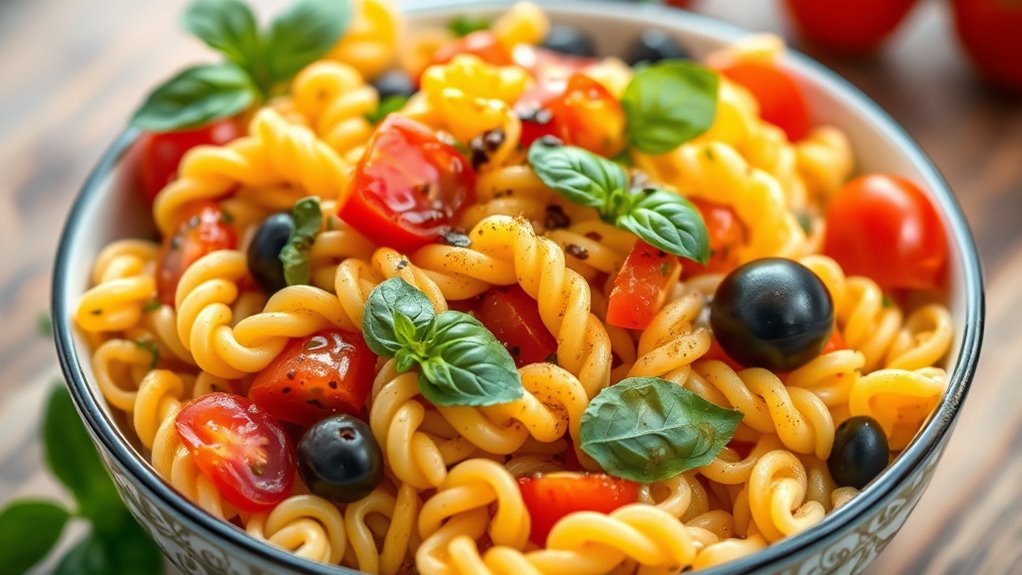
For a pasta salad, gather the essentials: 8 ounces of pasta, 1 cup of cherry tomatoes, 1 cup of cucumber, 1/2 cup of black olives, 1/2 cup of feta or mozzarella, 2 tablespoons of chopped red onion, and 1/4 cup of fresh herbs.
| Visuals | Texture |
|---|---|
| Fresh vegetables on a bright board | Tender pasta, bite after bite |
You’ll pick pasta types that suit your mood—short shapes for scooping, long strands for twirling—and keep flavors crisp with crunchy veggies. Choose olive oil, lemon, or vinegar as your bright, balancing note. This foundation respects freedom: simple ingredients, clear ratios, and room to customize without crowding the palate.
Preparations
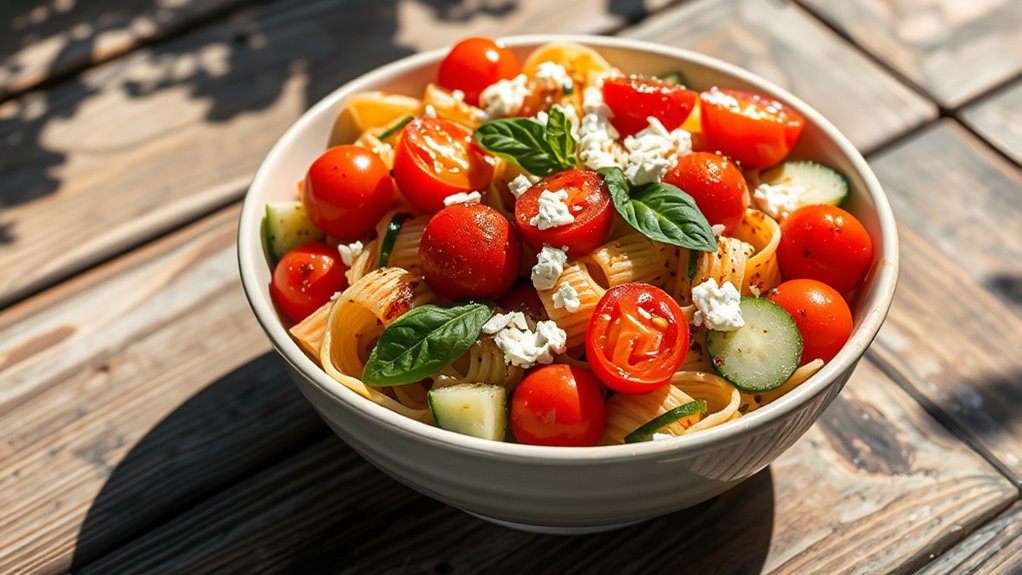
Start by cooking the pasta in salted water until al dente, then drain and rinse briefly under cold water to stop the cooking and cool it for mixing. You’ll focus on efficient prep, keeping flavors balanced and adaptable. Prepare components ahead, so you can assemble quickly and confidently, and consider substitutions that suit your pantry or taste. This section centers on thoughtful preparation techniques and flexible ingredient substitutions, ensuring you control texture, brightness, and tang. You’re encouraged to trust your palate and adjust ratios as you go, crafting a harmonized salad that feels liberated from rigidity. Stay precise: measure oil, balsamic, and herbs, then fold with care for even coating and bite.
- Silky pasta, glossy with vinaigrette
- Bright vegetables, crisp and colorful
- Creamy or tangy cheese, creamy without clumping
- Herbaceous pops, fresh and aromatic
- Flexible swaps, pantry-friendly substitutions
Kitchen tools or Kitchenware Required
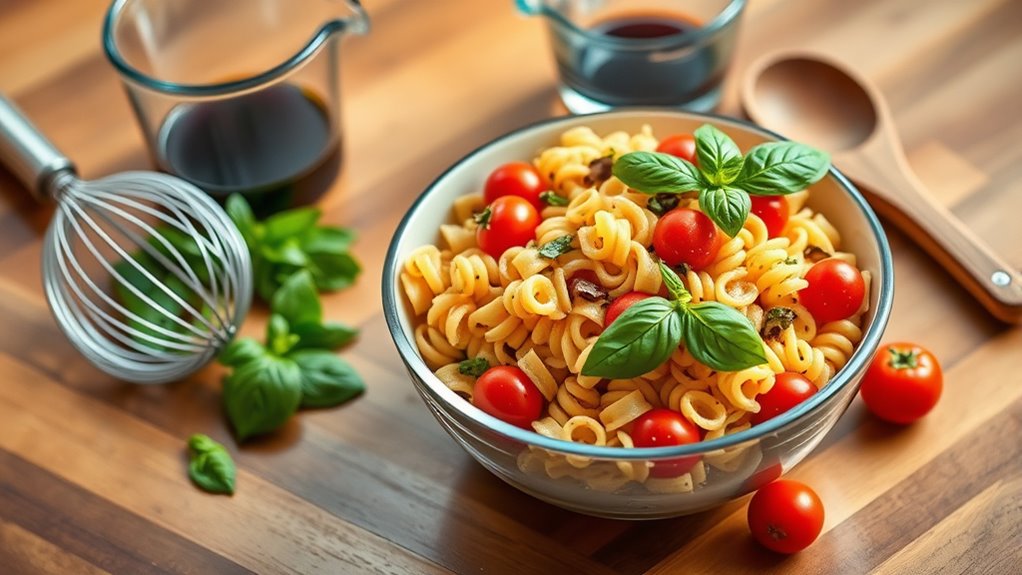
A well-equipped kitchen makes this pasta salad come together smoothly: you’ll want a dependable pot for boiling, a colander or sieve for draining, and a wide mixing bowl for tossing. Beyond basics, you’ll appreciate a sharp chef’s knife, a cutting board, tongs, and a whisk to emulsify dressing. For measuring, have a set of graduated cups and spoons, plus a thermometer if you like precise timing. Storage isn’t optional: airtight containers keep leftovers fresh. The right tools save time and preserve texture, so invest in durable, easy-to-clean pieces. Kitchen essentials and necessary utensils here support smooth prep, confident chopping, and even mixing.
| Tool | Purpose | Tip |
|---|---|---|
| Pot | Boiling pasta | Use salted water |
| Colander | Draining | Shake gently |
| Mixing bowl | Tossing | Choose wide, sturdy |
How to Cook
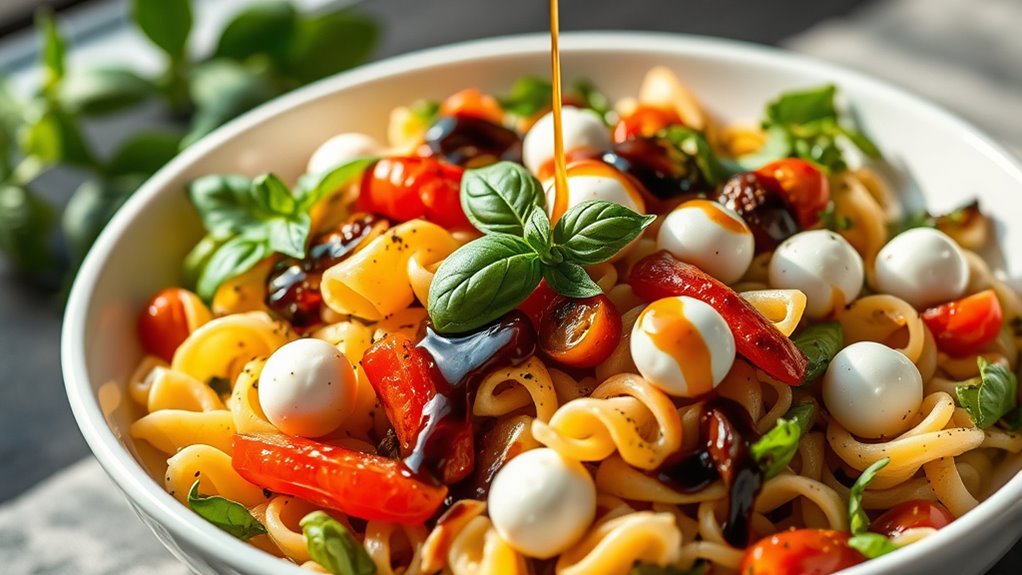
- Choose pasta types that hold sauce and have a good bite.
- Boil salted water in a pot until it reaches a rolling boil.
- Add pasta and monitor timing carefully to achieve al dente texture.
- Drain pasta and cool briefly to stop carryover cooking.
- Prepare mix-ins such as charred vegetables and soft mozzarella.
- Rinse greens gently to keep them crisp and avoid sogginess.
- Toss pasta with balsamic glaze, olive oil, and your chosen herbs.
- Balance acidity with sweetness to keep the salad lively and fresh.
- Serve with chewy pasta anchoring every bite and bright herbs scenting the air.
How to Serve
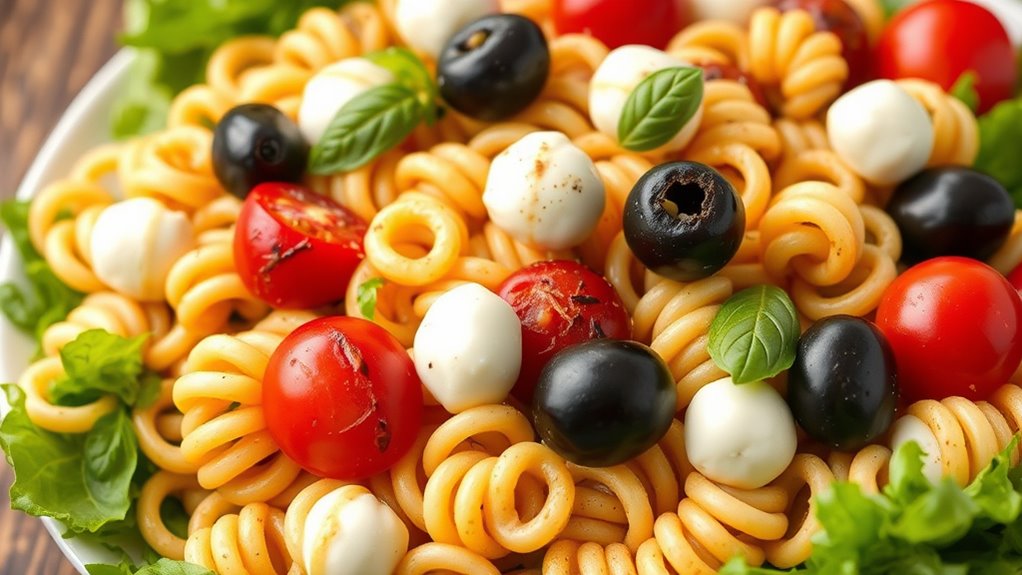
To serve this pasta salad at its best, build the plate with balance in mind: a generous spoonful of pasta, a mix of vegetables for color and crunch, and a few bite-sized mozzarella or protein additions if you like. For serving suggestions, keep the dressing bright on the side or lightly tossed so each bite remains fresh and vibrant. Plate with deliberate spacing: arrange greens as a bed, fold in tomatoes, olives, and herbs, then crown with cheese or protein. Use plating techniques that highlight color contrast and texture, like a gentle twist of pasta on the rim or a small, neat mound at the center. Serve promptly, and invite guests to mix for personalized flavor.
Tips
Here are practical tips to keep your pasta salad fresh, flavorful, and appealing. You stay in control of texture and taste, balancing bright dressing with crisp veg. Chill everything before mixing, then fold gently to avoid soggy strands. Use dressing variations that match your mood—zesty balsamic, lemony, or herb-forward options—and adjust salt last to preserve brightness. For ingredient substitutions, swap olives or feta with sun-dried tomatoes or goat cheese to alter mood without losing cohesion. Pack components separately if preparing ahead, then combine just before serving to maintain bite. Taste as you go and keep portions modest to prevent heaviness. Opt for a tangy, clean finish that invites second helpings.
Chill, fold gently, and tailor dressing for a bright, bite-ready pasta salad.
- Crisp vegetables glistening with light-amber dressing
- Shimmering pasta threads catching a glossy glaze
- Colorful feta, olives, or tomatoes adding contrast
- Aromatic herbs releasing fragrant notes
- A final drizzle that brightens without overpowering
Food Value and Benefit
A well-made pasta salad provides a balanced, convenient meal rich in protein, fiber, vitamins, and minerals. Key components like beans, cheese, or lean meats supply protein that supports muscle maintenance and satiety. Whole grains or quinoa add fiber for digestive health and steady energy release. Vegetables contribute essential vitamins and minerals, while healthy fats from olive oil, nuts, or seeds improve nutrient absorption and promote fullness.
Food Value:
- High-quality protein from beans, cheese, or lean meats
- Dietary fiber from whole grains, quinoa, and vegetables
- Vitamins including Vitamin A, Vitamin C, Vitamin K, and several B vitamins
- Minerals such as iron, magnesium, potassium, and calcium
- Healthy fats from olive oil, nuts, and seeds
Benefits of Eating This Recipe:
- Supports muscle maintenance and promotes satiety
- Enhances digestive health through increased fiber intake
- Provides antioxidant vitamins that support immune function and skin health
- Contributes to heart health by including healthy fats and whole grains
- Sustains steady energy levels for prolonged activity
- Helps maintain balanced blood sugar levels
- Promotes nutrient absorption and overall wellness
Enjoying this pasta salad with mindful portion sizes and dressing choices makes it a versatile meal option that supports weight management and overall health.
Frequently Asked Questions
Can I Use Gluten-Free Pasta for This Recipe?
Yes, you can; try gluten-free options. You’ll want reliable pasta brands, check texture, and adjust sauce because gluten-free options cook differently. You’ll enjoy freedom to customize while keeping flavor bright and satisfying.
How Long Can Pasta Salad With Balsamic Be Refrigerated?
Pasta salad with balsamic lasts about 3 to 5 days in the fridge. For best flavor, keep it tightly sealed and refrigerated. Pasta storage tips: store separately or toss with balsamic dressing only before serving.
Can I Substitute Olives or Feta in This Dish?
Yes, you can substitute olives or feta. Consider olive alternatives like sun-dried tomatoes or cucumber, and feta substitutes such as ricotta salata or goat cheese. You’ll still enjoy bright flavors while staying true to your olive alternatives and feta substitutes.
Is Warm or Room-Temperature Serving Preferred for Flavor?
Go with room-temperature taste; you’ll notice brighter tomatoes and herbs that mingle well as it sits. If you prefer warmer, you’ll get a warmer flavor, but the contrast in texture shines best at room temperature.
Can I Prepare This a Day Ahead and Mix Before Serving?
Yes, you can prep a day ahead and mix before serving. Preparation tips: chill everything, drain lightly, and combine last minute for freshness. Serving suggestions: taste, adjust seasoning, and dress right before serving for maximum flavor.
